Wondering what tank mates you can keep with your oscar cichlid?
Oscar cichlids are hugely popular in the aquarium hobby. Not only do they look cool as heck, they also have killer personalities. In fact, every oscar I’ve ever encountered had its own totally unique personality. And that’s going to be important to remember when picking tank mates for your oscar: there are no hard and fast rules. This is because your os car will be every bit an individual like a pet dog or cat is. So, what fish you choose to go with your oscar will depend a lot on your oscar’s disposition. But, that doesn’t mean there aren’t places to start—we’re going to examine a huge list of potential tank mates for your oscar in this ultimate tank mate guide!
First Thing’s First: What Are Oscars?
Oscars are cichlids. Cichlids, or Cichlidae, are a family of fish in the order Cichliformes. Genetic research has positioned cichlids as related to saltwater convict blennies. As such, their bright coloration is understandable. Furthermore, like their saltwater cousins, cichlids are relatively intelligent and have well-developed personalities.
Cichlids have a broad distribution in Africa and South and Central America, but are also present in smaller numbers in North America and Asia.
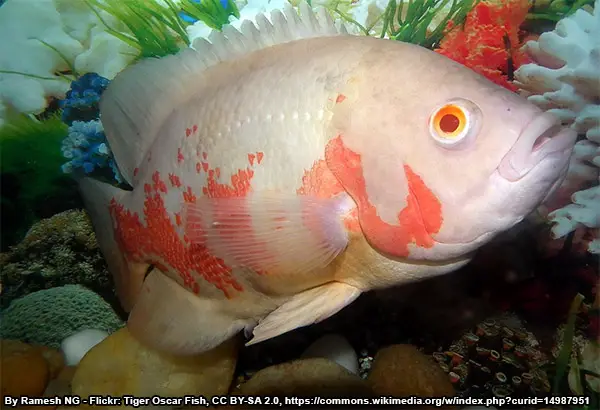
The smallest cichlid is less than an inch long (2.5cm)! Whereas, the largest is over three feet (1m) from nose to tail! Cichlids don’t just vary in length, they also vary in shape—some are flat, like pancakes (e.g. discus) whereas others are round and fat like a sausage (e.g. Julidochromis or “julies”).
So where do oscars position themselves in the family? Well, first of all, they’re from South America. More specifically, they’re from the Amazon as opposed to being from the west flank of the Andes. This is significant because South American cichlids that live outside of the Amazon basin are more closely related to Central American cichlids. Why does this matter? Well, because South American cichlids are generally more docile than their aggressive cousins from Central America. So, oscars being Amazonian means they are (typically, not always) a little more chill than Central American cichlids like red devils and convict cichlids. However, oscars are not necessarily, or even typically, amiable characters. Some are more aggressive, some are less aggressive. And bear in mind, like all cichlids, they are mercurial.
Lastly, it’s important to understand that oscars are longstanding favorites in the aquarium hobby. This means that, over generations, they have been bred in captivity . As such, they are very well suited to a broader range of water chemistry values. In particular, they cope well with what can be considered typical tap water. Furthermore, their domestication has meant they are used to eating commercial foods.
Before You Think About Tank Mates: What Does Your Oscar Need To Be Happy?
This question is very important because if your oscar is your “must have” fish for your aquarium then its needs should be met and then you should consider tank mates that are compatible. However, if you prefer other fish first and maybe an oscar as a second choice, then it could be that you’ll have to strike the oscar off your list!
So, as already mentioned, oscars are not demanding in terms of water chemistry. Generations of being captive bred in tap water has meant that they are very hardy and do well in a range of pH and hardness values. Although, it’s important to remember that this is only true of captive bred oscars. Wild oscars, naturally, are much more sensitive to water chemistry and an effort should be made to match their water to that in which they were caught. Typically Amazonian waters are soft and acidic. However, wild caught oscars are very rare in the hobby, and chances are the fish you buy will have been born and raised on an ornamental fish farm.
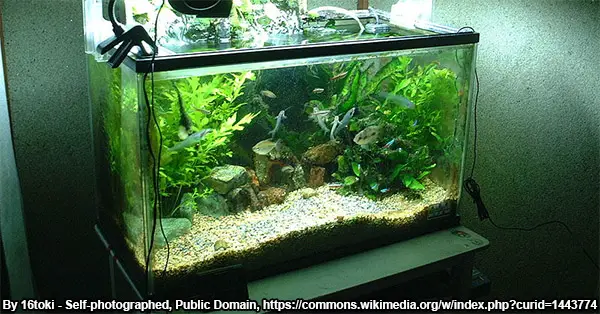
Other than water chemistry, oscars require a degree of large, open space in which to move around. In particular, they like to charge—they especially enjoy dashing at the glass when their owner is about to bring them food. So, any fish you want to keep with your oscar will need to enjoy that particular aquarium setup.
Additionally, oscars really enjoy digging! They like to pick up big mouthfuls of gravel or sand and move it around. So, this means other fish you’d like to keep with your oscar will have to be okay with having the furniture regularly rearranged.
And finally, oscars like to destroy plants. So, if a fish you want to keep with your oscar requires thick plant cover to feel safe and secure, well, think again!
What Do Oscars Eat? And Is That Compatible With Tank Mates?
In an aquarium, it can be very difficult to make sure one fish in your tank eats one food, while another fish in your tank eats a different food. Not impossible, but you know, one of those bothersome inconveniences that build up over time. So, when you’re considering tank mates, it’s a good if it’s safe if they eat similar diets.
Luckily for you, oscars are not fussy eaters. However, they do best on a diet designed for cichlids (Hikari’s Cichlid Gold is a personal favorite of mine (affiliate link)).
Oscar Tank Decorations
Oscars are territorial. This is important to consider when decorating an aquarium intended to keep oscars with other fish. Typically, territoriality is conspecific. However, it can extend to other species of fish—especially other cichlids.
For breeding purposes, an oscar’s territory typically centers around a hole dug in the substrate—even better a depression with a flat, clean surface upon which to lay eggs, e.g. a piece of slate laid flat. So, if you provide a suitable breeding spot for a breeding pair of oscars, you might find they settle on that spot and begin breeding. This is important because their aggression levels to any other tank mates—no matter the species—will increase while in “breeding mode”.

So, naturally, you might be considering not providing your oscar pair with a suitable breeding spot so as to protect tank mates from their aggression? Well, where there’s a will there’s a way. Oscars will simply dig out a divot in the substrate and happily lay their eggs on the bottom pane of glass!
Long story short: if your oscars begin breeding then some tough choices about re-homing tank mates might have to be made.
As much as we talk about oscars being aggressive and tough—and a lot of the time they sure are—but, some oscars are total wimps! So, if you find your oscar is an insecure fellow, then this should be taken into consideration when decorating its take, i.e. you should provide it with hiding spots in order to feel safe. While they might be aesthetically pleasing, many keepers of larger cichlids settle for terracotta plant pots as hiding holes for their fish.
Keeping Oscars With Other Cichlids
Our first instinct as fishkeepers might be to pair like with like, i.e. keep cichlids with cichlids. But, my advice if you’re newer to the hobby is to resist that urge. This is because cichlids can be very aggressive, very territorial, and very temperamental. So, mixing and matching them can prove for combustible encounters. However, if you are determined to keep your oscar with other cichlids rest assured it can be done. But, it must be done with care and an adequate backup plan. Ideally, another home should be ready and waiting in case one or more of your cichlids are bullied and injured.
Location, Location, Location!
While it’s true that every cichlid is an individual—you might find a placid mbuna and a vicious angelfish—we can count on some mostly true generalizations about cichlids based on where they are from. For example, African Rift Lake cichlids and Central American cichlids tend to be much more aggressive than their Amazonian counterparts. Further complicating the issue is the fact that African riverine cichlids (e.g. kribensis) are quite peaceable. Whereas, non-Amazonian South American cichlids are closely related to Central American cichlids and, as such, tend to be quite quarrelsome at times.
Old World Cichlids
Old world cichlids—i.e. African and Asian (there are no European species of cichlid)—are generally divided into groups based on where they’re from. For example, fishkeepers might have a Malawi tank or a Tanganyika tank; this means that their tank is either dedicated to cichlids from Lake Malawi or Lake Tanganyika, both of which are African rift lakes. Further complicating the issue are riverine species like kribensis (Pelvicachromis species) and tilapia. But, that’s not where African cichlids end, there are also species from other lakes like Lake Victoria, and even species from the island of Madagascar are available in the aquarium hobby nowadays.
So, let’s get down to it: can we keep African cichlids with oscars? The answer really depends. Some fishkeepers will tell you no, absolutely not. Whereas others have been able to keep oscars and frontosa (a Tanganyikan cichlid) together with a degree of success.
Keeping Oscars With Lake Malawi Cichlids
Keeping an oscar with Malawi cichlids is, sadly, a typically futile endeavor. Out of all the cichlid species, Malawi cichlids (mbuna, haps, et al) have a deserved reputation for being among the most aggressive fish in the aquarium hobby. And while we might like to think our oscar fish are big tough guys, the truth is that they can be quite timid. The hobby is littered with stories of fishkeepers failed attempts to keep oscars in a mbuna tank. Spoiler: they all end with the oscar being bullied and injured.
Furthermore, water parameters should be a consideration. Amazonian cichlids (like oscars) tend to prefer softer more acidic water, whereas African rift lake cichlids prefer harder, more alkaline water. Although, this has become less and less important over the years. The reason water chemistry matters less now than it did in the past is because most aquarium fish have been captive bred over generations. This captive breeder inherently leads to pet fish more tolerant of different water chemisties—specifically, the kind of tap water most of us have. Also, concerning temperature, both Malawi cichlids and oscars are tropical fish and share similar temp requirements.
Keeping Oscars With Lake Tanganyika Cichlids
Generally speaking, Tanganyikan cichlids have a reputation for being somewhat less aggressive than their Malawian cousins. However, they remain African rift lake cichlids and, as such, are typically more quarrelsome than their Amazonian counterparts, e.g. oscar cichlids.
Can You Keep Oscars With Tanganyikan Shellies?
For those unfamiliar with shell dwellers (or shellies), the clue about their defining feature is in the name: they live in shells! And, most of the shells they live inside of are pretty small. Therefore, they are small. So very small, in fact, that they are too small to be kept with oscars—they’ll be nothing but a tasty snack for your hungry oscar.
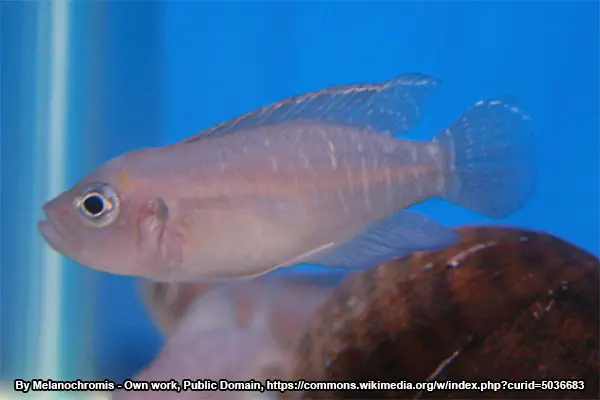
If you’re tempted to think that your shell dwellers could safely hide inside their shells from your oscar, think again. Typically, an aquarium setup for shell dweller cichlids has a layer of shells along the substrate for the dwarf cichlids to inhabit. However, your oscar will probably delight in digging around in this layer of shells and shunting them all over the tank.
Keeping Frontosa With Oscars
Frontosa are a popular aquarium fish originating from Lake Tanganyika. Out of all the common Tanganyikan fish in the hobby, the frontosa might be best suited to be kept with oscars. However, that does not necessarily mean they represent easy, or even sensible, tank mates for your oscar.
With regards to water parameters, if both your oscar and any frontosa you want to keep with your oscar are tank raised, then pH, hardness, etc won’t matter too much. But, if either are wild caught, then they will require you to emulate the water chemistry of their natural habitat. Firstly, for oscars, that would mean soft, acidic water. Whereas, with fronts, you’d need to provide hard, alkaline water. So, as you can see, wild caught oscars and frontosa are not compatible.
Another issue with keeping oscars and frontosa together is their differing growth rates. Oscars grow very quickly indeed, whereas frontosa are notoriously slow growers. So, while full grown oscars and full grown frontosa are reasonably close in size, the reality is that if you buy juveniles the oscar will outpaced the frontosa which could ultimately cause issues.
So, it is possible to keep fronts and oscars together successfully and, while it may be controversial, there are examples of it. However, they do not represent an easy pairing—there are better alternatives for sure!
Keeping Tropheus With Oscars
Tropheus are another group of Tanganyikan cichlids that are somewhat common in the aquarium hobby.
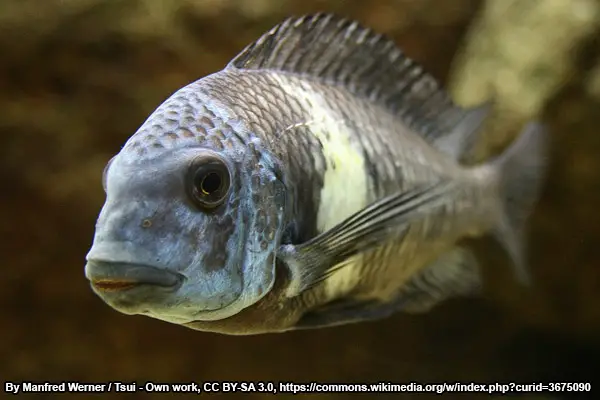
Tropheus grow to be about half the size of oscars, which isn’t necessarily a problem, but it also isn’t ideal! Furthermore, tropheus like to be kept in large groups—and those large groups are very active, moving and jostling constantly. This constant motion jars with oscar behavior—they are typically more sedentary but prone to sudden bursts of energy. Lastly is the issue of diet: trophs are notorious algae grazers. They need plant matter in their diet to remain healthy. Whereas, oscars subside on a diet of invertebrates. As such, you may find issues with feeding each fish its required diet without the other gobbling up the “wrong” food.
So, unfortunately, tropheus don’t make good tank mates for oscars.
Keeping Oscars African Riverine Cichlids
Often in the aquarium hobby we can be guilty of thinking that the world of African cichlids begins and ends with the rift lakes. However, this is not the case. There are a number of African riverine cichlids available in the hobby.
Keeping Kribs With Oscars
Pelvicachromis species (or kribs/kribensis) are very common in the fishkeeping hobby. Specifically, Pelvicachromis pulcher is ubiquitous.
Regarding water quality, P. pulcher, like has been captive raised for generations. So, both oscars and kribs are—barring any extremes—going to be happy in your tap water. Furthermore, even though oscars and kribs are from opposite sides of the Atlantic, their natural habitat is quite similiar, i.e. tropical and heavily forested. Such an environment makes for tannin-rich, soft, acidic water.
The disposition of oscars and kribs is also similar. As cichlids, every fish is very much the individual. However, generally speaking, oscars and kribs are somewhat peaceful as far as cichlids go. Ultimately though, oscars are probably more often aggressive than kribs are.
In spite of their temperament and water requirement match, kribs and oscars make for poor tank mates. This is because kribs are a dwarf cichlid, reaching a maximum of only four inches (~10cm). Whereas, oscars are big boys, maxing out at 12 inches (~30cm). So, as you can imagine, not only would a full grown oscar be capable of bullying a tiny krib, it would also be inclined to swallow its tank mate whole.
Famous African Cichlid Food Fish – Tilapia and Oscars As Tank Mates
In times gone by, the term “tilapia” was a simpler one. This is because the many species of fish with the common name “tilapia” were all scientifically classified under the same tribe. However, in recent times that large tribe—tilapiini—has been broken into the coelotilapine, coptodonine, heterotilapine, oreochromine, pelmatolapiine and tilapiine tribes.
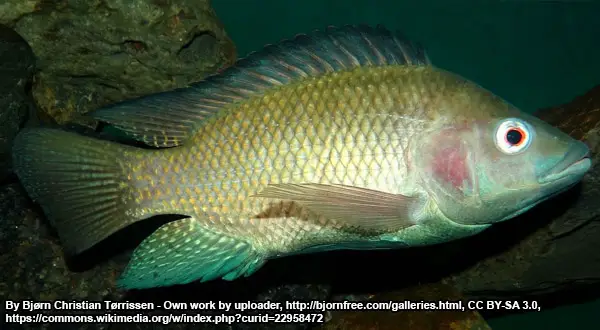
Because of this complexity regarding what is or isn’t considered tilapia, considering both their common and scientific names, it’s better to simply focus on the species of “tilapia” you might encounter in the aquarium hobby.
One of the most common tilapia species that finds its way into the hobby is the zebra tilapia or Heterotilapia buttikoferi.
New World Cichlids – South America
If you want to keep your oscar with other cichlids, the best place to start is probably going to be with its fellow New World (i.e. North, Central, and South American cichlids). Although, it’s better to hone the choice even further to not just American cichlids, but rather Amazonian cichlids!
Sure, matching oscars with other Amazonian cichlids means they’re likely to require similar water parameters. However, that isn’t the main concern because—as mentioned previously—oscars are typically captive raised and have been for generations. Therefore, they have become accustomed to tolerating a much wider range of water parameters.
So, if matching water type isn’t the main reason for pairing oscars with their fellow South American cichlids, then what is? Well, size and temperament. There are other Amazonian cichlids—e.g. severums, uara, some geophagus—that grow to a size that allows them to hold their own with an oscar, while having a relatively even temper (for cichlids, that is).
Keeping Angelfish With Oscars?
Let’s start with the most commonly available Amazonian cichlid available in the aquarium hobby: the freshwater angelfish.
Do angelfish make good tank mates for oscars? There are aquarists out there who have had success keeping oscars and angelfish together. However, it’s not an ideal combination for a couple of reasons. Firstly, the size difference. Oscars grow much larger than angelfish, they’re also thicker and more robust. In addition to the size difference is the behavior difference: oscars are generally more aggressive and domineering than angelfish. Put simply, oscars are real bruisers, whereas their angelfish cousins are much more delicate.
So, regarding oscars and angelfish together, you might be able to keep them together peacefully while your oscar is very small. However, keep in mind that the oscar will grow very fast and will soon pose a threat to the safety of its angelfish tank mates.
Do Acara Make Good Tank Mates For Oscars?
There are a number of acara species available in the aquarium hobby. While their scientific classifications have changed over the years as biologists have revisited their relationship, the common names in the hobby have stuck. However, there is a degree of uncertainty with both scientists and hobbyists as to the true relationship between fish given the common name “acara”.
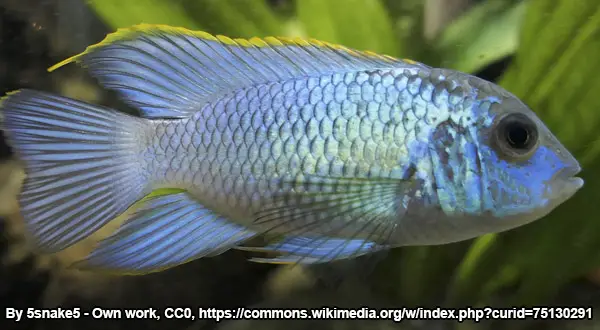
Regardless, let’s use the common names and consider each acara species and its compatibility as a tank mate for your oscar cichlid.
Blue Acara With Oscar Tank Mate
Blue acara are an interesting option for an oscar tank mate. Like the oscar, they’re a well-established ornamental hobby fish. Therefore, they are well-adjusted to a range of water chemistry values. Temperament-wise they can be a match, but with both being cichlids it’s important to remember they will have their own personalities. However, size can be an issue—a blue acara tops out at around 6 inches (15cm), whereas your oscar will grow to double that. So, naturally, a full grown oscar might give your blue acara some grief in the aquarium.
Zebra Acara With Oscar Tank Mate
The zebra acara presents a less attractive option for an oscar tank mate than the blue acara for a number of reasons.
Firstly, the zebra acara is less common in the hobby—this means your fish might be wild caught or only a couple of generations into being captive bred. This is important because a zebra acara might need you to emulate its natural habitat’s water parameters more closely when compared to the hardier oscar cichlid.
Secondly, size is an issue. The zebra acara has a slightly smaller maximum size when compared to the blue acara. This means that a fully grown oscar cichlid could very well intimidate, bully, and/or injure your zebra acara.
Threadfin Acara With Oscar Tank Mate
Threadfin acaras bring attention to the problematic naming of “acara” fish in the hobby. Sometimes it is known as a geophagus rather than an acara. Furthermore, it is (at the time of writing) classified in the “Geophagini” tribe.
Out of the three acaras we’re looking at, the threadfin is by far the largest. Specifically, the threadfin acara grows to almost 8 inches (20cm). This makes it—size-wise at least—a better match for your oscar than the zebra or blue acara. However, they are quite peaceful in terms of temperament. Furthermore, their trailing fins and slower movement might make pairing them with an oscar problematic. Overall, it might be possible to keep them successfully with your oscar, but it will vary based on individual cichlid personalities. So, mix with care. But, there are better options.
Discus With Oscar Tank Mate
Mixing discus with oscars would be an interesting experiment, for sure. But, it’s not a common mix for a good reason.

Discus are quite delicate fish, similar to angelfish in size, shape, and temperament. So, naturally, it’s something that could work if your oscar was particularly docile and the aquarium was decorated in such a way as to meet the needs of both fish.
However, the recommendation has to be against rather than for mixing oscars with discus. This is because, in all likelihood, the oscar will be too boisterous for the discus and leave them timid and poorly colored. Add to this the fact that decent quality discus are expensive and you have a very costly recipe for stressed out and dull discus.
Severum With Oscar Tank Mate
Severums present a very solid option for hobbyists intended to pair oscars with another fairly large cichlid.
Not only do severums reach a similar size to oscars—12 inches (~30cm)—they also hail from the same part of the world: the Amazon basin. Therefore, oscars and severums share compatible water parameter requirements.
It’s become a common refrain: when mixing cichlids, the individual personality of the fish must be taken into account. Severum temperaments can be likened to angelfish and discus, but they are generally slightly more territorial and aggressive. As always, it’s entirely possible you could obtain a particularly docile severum, or an aggressive one (and anywhere in between). Also, the same applies to your oscar. As such, it is important to have a back up plan to rehome your cichlids if they don’t get along.
Another benefit of severums is the number of varieties available. The most widely available color form is the green severum. However, there are gold forms bred from mutations in captive populations. Another form—the red spot severum—exists and, as the name suggests, is dotted with red spots. Finally, consider the rotkeil severum. The name “rotkeil” which translates from German into red (rot) wedge (keil). Again, the name is apt, because the rotkeil severum possesses a bright red wedge of red coloration on its flank.
Any of the above severum color forms can be considered as tank mates for your oscar.
Final word on diet: severums will happily eat the meatier foods your oscar likes, such as bloodworm. However, it can be beneficial to make sure severums have some veggies in their diet to keep them regular.
Uaru With Oscar Tank Mate
Uaru share a lot of the same advantages as their relatives the severum. For example, like both oscars and severums, uaru are Amazonian fish. As such, they’re typically happy in the same water conditions as their cousins. They also match up size-wise; because uaru reach a maximum size of around 12 inches (~30cm). Sure, severums are typically robust enough to be kept with oscars, but uaru are even chunkier and even better able to handle themselves with oscars.
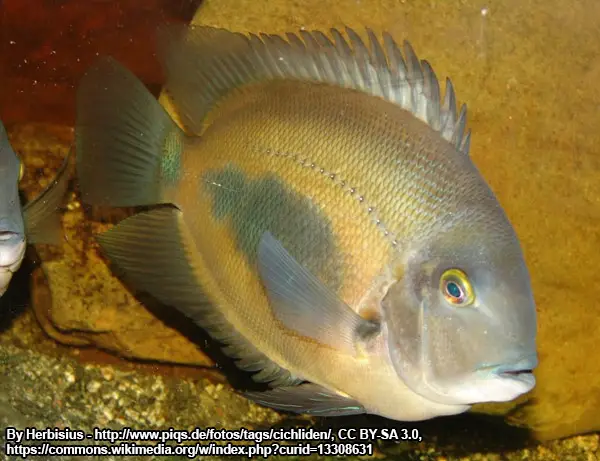
Unlike severums, though, uaru do not come in as many color forms. Their appearance, regardless, is appealing. Uaru possess a bright orange eye and striking black patch on the flank.
Like severums, diet-wise, they will appreciate some greens.
Peacock Bass With Oscar Tank Mate
For the vast majority of fishkeepers, peacock bass (members of the cichla genus) are simply out of reach. This is because of their massive adult size—they reach over three feet long (1m). In addition to that, they are piscivores; this means that peacock bass will actively prey on other fish. Consider the peacock bass’s mouth in relation to the size of its body—its mouth is large… very large! Unless your oscar is fully grown, there’s a very good chance a peacock bass would eat it.
So, let’s imagine you have an aquarium (more like a pond) large enough, and put the size concerns aside. Do peacock bass represent good tank mates for oscars? Actually, in all other parameters they make decent tank mates for oscars. This is because, like oscars, severums and uaru, peacock bass are native to the Amazon basin. This means peacock bass share water parameter requirements with oscars.
Diet-wise there is some crossover. While oscars will prey on smaller fish, they mostly feed on invertebrates. Whereas, peacock bass are more dedicated piscivores. A cichlid pellet with a reasonable amount of protein would suit both fish.
However, we cannot ignore the size issue. Peacock bass require monstrous aquariums/ponds. Additionally, they are likely to prey on small-medium sized oscars. So, a fully grown oscar would be a requirement.
Geophagus With Oscar Tank Mate
Geophagus represent an interesting option for oscar tank mates. This is because they are, like oscars, South American cichlids. Therefore, you might be quick to assume they require similar water chemistry. However, unlike oscars, geophagus species generally hail from outside the Amazon’s basin.
However, do not place too much importance on this. The commonly available geophagus species in the aquarium hobby have been captive bred for generations. As such, like oscars, they have been adapted to a range of water conditions unlike their native conditions and more like the kind of tap water most of us encounter. So, unless you have either wild caught geophagus or wild caught oscars, water chemistry should not concern you too much.
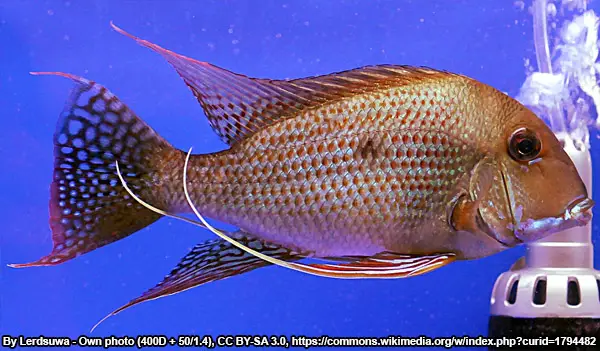
The size of geophagus is worthy of consideration. G. altifrons, G. brasiliensis, G. sp. “red head” and Gymnogeophagus balzanii can all be expected to max out around 8-9 inches(~22cm). It is worth noting that females are generally smaller. Regardless, a fully grown geophagus will be too big for your oscar to eat, but could be small enough to be bullied depending. Of course, any bullying depends on the personalities of the fish involved.
Feeding should also be a consideration. This is because your oscar will eat from the surface, while your geophagus prefer to eat nearer the bottom. So, ideally, feed your oscar a floating pellet, and perhaps serve some sinking food for geophagus. Geophagus are omnivores and will do well on a cichlid pellet such as Hikari cichlid gold (affiliate link).
Rams And Apistogramma Species With Oscars? Bad Idea?
South American dwarf cichlids—rams, Bolivian rams, and the range of apisto species—are great fish: colorful, entertaining, and a wonderful breeding project. However, owing to their small size, they make for terrible oscar tank mates. You might be able to house the smallest, youngest oscar with dwarf cichlids for a week or two, but it won’t be long before your oscar grows big enough to make a problem of itself.
While it’s a moot point considering the above, Amazonian dwarf cichlids are a water parameter match for oscars.
Both oscars and South American dwarf cichlids feed on invertebrates, just oscars eat larger ones while dwarf cichlids eat smaller ones.
Ultimately though, keeping rams or apistogramma species with an oscar is a very, very bad idea.
Keyhole Cichlids With Oscar Tank Mate
Keyhole cichlids (Cleithracara maronii) are notoriously peaceful, small cichlids. Growing to 4 inches (~11cm) means that, unfortunately, they are a little on the small side to be paired up with your oscars. And, while they do not hail from the Amazon basin, they do come from the Orinoco. The Orinoco has similar water chemistry to the Amazon, i.e. soft and acidic. Therefore, oscars and keyhole cichlids have similar requirements.
New World Cichlids – Central America
When grouping American cichlids in our mind, it’s important not to lump South American and Central American cichlids into the same group. This is because they are, generally speaking, quite different. Again, painting with a broad brush, South American (especially Amazonian) cichlids are much more peaceful than their Central American counterparts. So, pairing your (relatively) peaceful Amazonian oscar with a marauding, ruthless red devil cichlid might prove problematic.
Central American cichlids also come from a more diverse set of habitats. For example, some inhabit hard, alkaline lakes. While others occupy softer, more acidic rivers. Some species inhabit both! So, it’s fair to say you’ll find that, generally of course, Central American cichlids are more adaptable to whatever water comes out of your tap.
So let’s look at some of the commonly available Central American cichlids and consider them as tank mates for oscars.
Red Devil, Midas, & Other Amphilophus Species
The Amphilophus genus is an important one in the aquarium hobby. The members of the genus, such as midas, red devil, and trimac cichlids are all prized for their natural and unique beauty. In addition to that, they are used heavily in hybridization to create flowerhorn, mammon, and blood parrot strains.
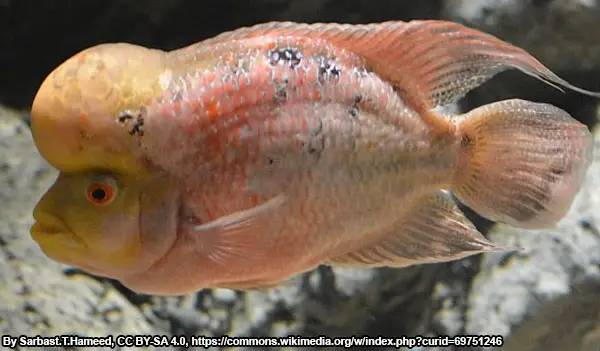
Are red devils, midas, and other amph species suitable oscar tank mates? They can be. But, mixing them must be done with the utmost of care and preparedness (i.e. be ready to re-home in the event of fighting). As with all cichlids, individuals may vary, but a large and quarrelsome Amphilophus could easily bully and kill a timid oscar. Especially considering red devils and midas cichlids can grow larger than your oscar (15 inches/38cm).
When it comes to water parameters, there should be no issues. Oscars, red devils, midas and even trimacs are typically farm raised. Therefore, they will be tolerant of a wide range of water chemistry parameters. Wild caught fish, of course, require extra care.
Amphs are omnivorous. So while your oscar will do well on a meatier diet, your red devil or midas cichlid will like some greens on the menu. Keep that in mind.
Convict Cichlids Good Oscar Tank Mates?
Like most Central American cichlids, convicts have a reputation for being belligerent. However, unlike Amphilophus and Parachromis species, they don’t get quite as large. Convicts rarely exceed 6 inches (~15cm). So, naturally, this smaller size makes their aggression less of a risk when pairing them with oscar tank mates.
Convicts are one of the most easily bred cichlids. So, you are much more likely to encounter tank raised fish. As such, convicts are very well suited to a range of water parameters.
Are Firemouths Good Oscar Tank Mates?
Firemouths are similar to convicts in ultimate size—they can reach a slightly smaller size of 5 inches (~12cm). So, being slightly smaller again, they might actually find themselves bullied by an aggressive oscar, in spite of Central Americans typically being more aggressive.
So, keeping oscars and firemouths together would be possible. But, like with all cichlid mixing, it’s something that has to be done with care. Careful observation is required.
Dovii, Jaguar & Other Parachromis Species As Oscar Tank Mates
Parachromis species are available in the hobby from time to time. Among the well known species are the jaguar cichlid, the wolf cichlid, and the tiger mota. These are all large, aggressive cichlids. The wolf cichlid, Parachromis dovii, grows to as large as 28 inches (72cm). So, members of this genus are significantly larger and than oscars. In addition, they are more often than not, more aggressive.
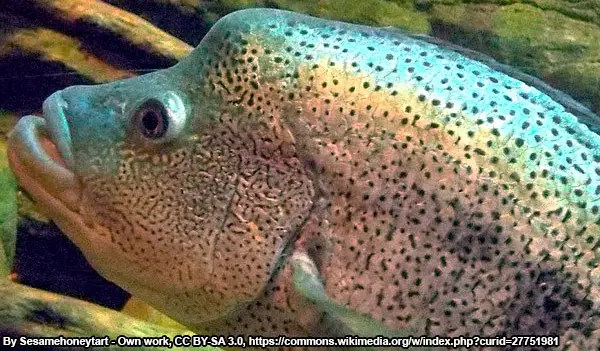
Considering the above, keeping oscars with dovii, jags, or mota cichlids can be challenging. But, as always with cichlids, it really depends on the personalities of the individual fish involved.
Regarding water parameters: these fish are tank raised for the aquarium hobby, and therefore—like oscars—are fairly hardy and tolerant of a wide range of water types.
Both oscars and Parachromis species are predators. However, what they prey on differs. Broadly speaking, Parachromis species are fish eaters. Whereas, oscars prefer to eat invertebrates. But, in general, fish are opportunists. Naturally, a dovii might gobble up a shrimp. While an oscar will happily eat a minnow if it can fit it in its mouth. This means a commercial food with a decent protein content will suit both fish.
Do Blood Parrots Get Along With Oscars? How About Flowerhorns?
Blood parrots, along with flowerhorns, are an interesting case. This is because both are hybrids, comprised of a number Central American cichlids. This makes judging compatibility a little bit different. After all, we don’t have wild fish to refer to. However, flowerhorns and blood parrots have been kept for decades now, and we understand their dietary and water parameter needs very well.
Being a domesticated hybrid means that they are tolerant of a broad range of pH and hardness values. Additionally, they are well-adapted to eating high quality commercial cichlid pellets. In fact, both flowerhorns and blood parrots have specialized food designed for them.
Whether it’s safe to pair them with oscars depends. Flowerhorns are known to be hyper aggressive, even for Central American cichlids. So, that could mean your oscar comes out worse for wear in a fight with a flowerhorn. Conversely, blood red parrots are known to be more docile. Furthermore, the shape of a blood parrot’s mouth means that it would struggle to harm an oscar, even if it was feeling quarrelsome.
Schooling Fish
Schooling fish from the Characin and Cyprinid families are more predictable, behavior-wise, than cichlids. As such, they are a more dependable choice for oscar tank mates. Also, they’re typically peaceful fish. However, some do nip fins; although, this should only concern you if you have a long finned oscar.
Tinfoil Barbs With Oscar Tank Mates
Tinfoil barbs are cyprinids. This means they are in the same family as carp like koi and goldfish. However, unlike the wild counterparts of koi and goldfish, tinfoil barbs originate from warmer parts of the world. Specifically, wild tinfoil barbs can be found in the Mekong basin and throughout much of tropical Asia.
In terms of behavior, tinfoil barbs are lively, active, schooling fish. So, as tank mates for your oscar they will provide contrast to an oscar’s more sedentary habit.
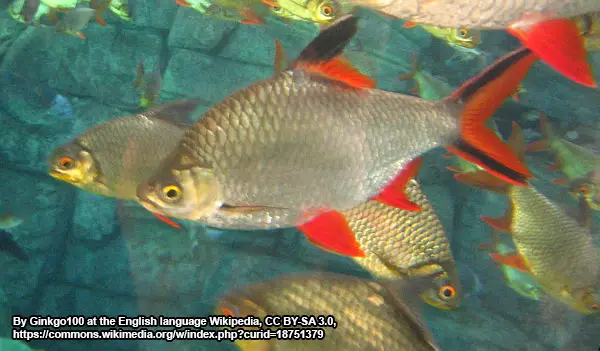
Tinfoil barbs grow quite large, and do so quickly. They reach around 13 inches (or 35cm). As such, they are suitably sized to share an aquarium with oscars. However, the aquarium should be large. This is because tinfoil barbs are schooling fish, and should be kept in groups.
In the wild tinfoil barbs are opportunistic omnivores. However, like goldfish, the bulk of their diet is comprised of plant matter. In your fish tank, you can expect them to accept quality commercial fish foods. However, they will also benefit from blanched vegetables.
Your oscar will likely not find a small school of tinfoil barbs disagreeable. However, your oscar could flare at them or threaten them if they come too close. But, as long as the aquarium is large enough the tinfoil barbs will be able to escape—they are very fast swimming fish.
Bala Sharks With Oscar Tank Mates
Bala sharks are very similar to tinfoil barbs. Like tinfoil barbs they are relatively large cyprinids. Again, like tinfoil barbs, they are silver. Where bala sharks differ is in body shape: they are more elongated, whereas tinfoil barbs have a deeper body.
Bala sharks are less common in the wild, though. Their range is limited to Borneo, Sumatra and parts of Malaysia.
Behavior-wise, bala sharks are energetic schoolers. While your oscar may pause in place for extended periods of time, its bala shark tank mates will zoom back and forth along the length of your aquarium.
Talking about size, bala sharks reach a max of 14 inches (35cm). So, they are definitely in the safe size range to be housed with your oscar.
Bala sharks are true omnivores. In the wild, they are known to eat invertebrates and plants.
A small group of bala sharks will likely live contently alongside your oscar. While your oscar might flare at or chase your sharks, they are fast swimmers and can escape easily.
Pacu With Oscar Tank Mates
Pacus grow big (40″/100cm for black pacu and 35.2″/88cm for the red-bellied species). They grow so big that the vast majority of us should never attempt to keep them. However, if your aquarium is big enough then a pacu can make a great oscar tank mate.
Like oscars, pacu are Amazonian fish. As such, their water requirements are similar. Furthermore, pacu are, like oscars, well adjusted to life in captivity. This is because they are cultivated as a food fish in parts of South America.
Like most fish, pacu are, of course, opportunistic feeders. This means they will eat small fish on occasion. However, they are primarily herbivorous fish. In addition to eating plant leaves, they also eat fruit and nuts that fall from overhanging trees and lands on the river’s surface.
Will a pacu get along with an oscar? Yes, very well. This is because the pacu is peaceful. Whereas, an aggressive oscar will not be big enough to threaten a fully grown pacu.
Silver Dollars With Oscar Tank Mates
Think of them as the pacu’s smaller cousin. Although, still large enough to hold their own with oscars.
Many species fall under the common name “silver dollar”. Some really are large, round, and plain silver. However, others have stripes or patches of red, black, and/or yellow. So, it’s worth researching the many different species of silver dollar in the hobby and picking one you like.
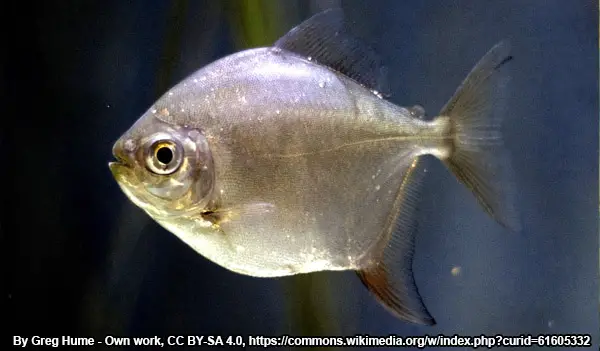
Again, being close cousins of the pacu means silver dollars love themselves some greens. Yes, they will eat commercial foods with a nutrition profile best balanced for typically omnivorous aquarium fish. However, to aid in their digestion and to ensure they remain healthy—like the pacu—make sure you throw in some blanched veggies on the regular.
Controversial Oscar Tank Mates: Goldfish
Goldfish and oscars are often in the same aquarium. But, it’s usually where a large oscar is being fed small goldfish as “feeder fish”. This is a bad practice, however: read why.
But, that doesn’t mean that oscars and goldfish can’t be kept together as happy tank mates. This scenario is often rejected by hobbyists for a number of reasons. Chief among reasons is the temperature difference. While it is true that oscars require tropical temperatures, it is not true that goldfish require cold temperatures. Feral populations of goldfish have been found thriving in tropical locations.
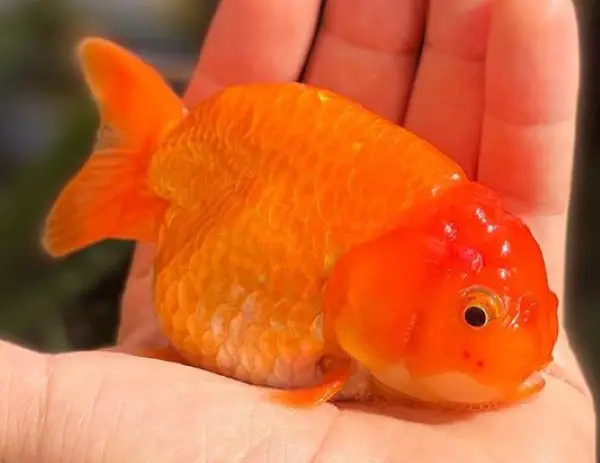
The next main objection would be that oscars eat goldfish. Yes, this is true. Oscars eat goldfish. However, only medium to large oscars eat small goldfish. Oscars would also eat small tinfoil barbs, small severums, and even small pacu!
Another objection is that goldfish are slow and have flowing fins that will be nipped. Yes, that also can be true of certain varieties. Under no circumstances should fancy goldfish be kept with oscars. Their deformed fins and bodies would mean an oscar would harass them and out compete for food.
However, a common goldfish with short fins (not a comet) is much like a tinfoil barb or a bala shark, i.e. it is a relatively large, fast swimming, energetic, robust cyprinid.
People will tell you that you can’t do it, but under the right circumstances common goldfish can be successfully kept with oscars.
Schooling Fish That Won’t Work With Your Oscar
There are lots of other schooling fish to consider. But, a lot of them won’t work with an oscar. This is because of their small size. Most tetras, rasboras, danios, and small barbs are poor tank mates for oscars. Oscars will usually devour small fish that easily fit in their mouths.
Some fish, though, walk the line. Giant danio, for example, reach four inches (10cm)—an oscar might eat a fish that big. But, then again, it might not. Roseline sharks (aka Denison barbs) will reach 6 inches (15cm). Although, they will be small enough for an oscar to eat while we wait for them to reach max size.
Catfish
Catfish are a popular oscar tank mate. This is because lots of catfish species are large. Also, while catfish species are often predatory, many are sedentary and peaceful. A big but placid catfish will be content to find a hidey-hole and relax there until either feeding time or lights out.
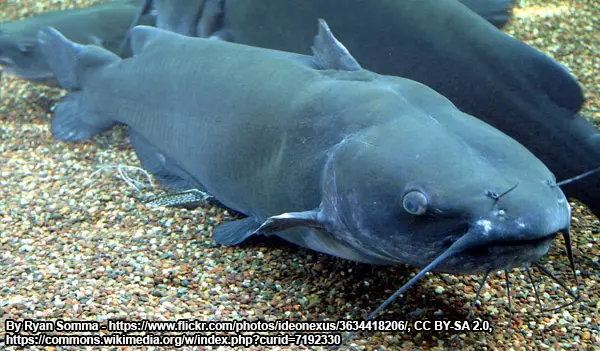
On the flip side, catfish have some major drawbacks that aren’t often discussed. Throughout the article, we’ve highlighted how oscars will eat anything that fits in their mouths. Well, your oscar might try to eat its catfish tank mate. In this case, the oscar may end up dead as well as the catfish it tries to eat. This is because catfish have spins in their fins. When attack they often erect their dorsal and pectoral fin spines, stabbing their assailant. Furthermore, a catfish can use its fin spines to lodge itself in a predator’s mouth or throat. In these cases, both fish can die.
So, Avoid Catfish Your Oscar Can Eat
So, considering the above, it’s important to rule out any catfish that your oscar can fit in its mouth. Corydoras, therefore, are immediately ruled out. As are any of the smaller pleco species. Even some synodontis, e.g. petricola, are too small to be kept with oscars.
Big Boy Catfish
Large catfish—like common plecos, walking catfish, channel cats, red tails, etc—are fine tank mates for an oscar. However, be sure neither catfish or oscar is much larger. Because, a large catfish will eat a small oscar. The converse is also true.
Loaches
Loaches, being bottom feeders, are often touted as catfish alternatives. However, many species simply do not grow big enough to be suitable oscar tank mates.
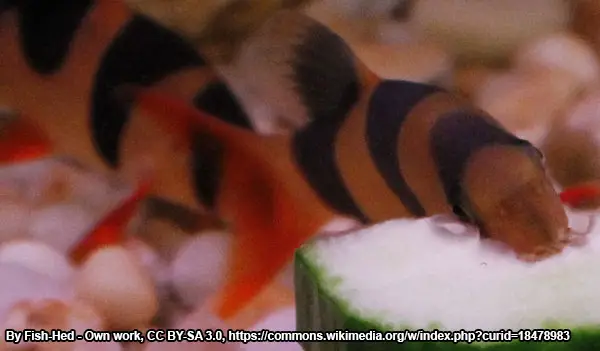
For example, popular fish like kuhli loaches and hill stream loaches are small to be housed with oscars. And even though dojo loaches grow quite long, they are slender and could fit in your oscar’s mouth.
However, there are some genuine giants among the loach species. Specifically, consider the perennial favorite: the clown loach. Clown loaches can reach 12 inches (30cm) in length. Although, typically they do not reach that size. Most clown loaches in the aquarium reach around 8 inches (20cm).
Oddballs & Predatory Fish
Oddballs, by their nature, are difficult to categorize. As such, it’s difficult to make sweeping statements about their suitability as oscar tank mates. Having said that, though, some oddball fish make great companions for oscars.
Are Bichars And Oscars Suitable Tank Mates
First and foremost, bichirs should be considered. These are, like many catfish, fairly placid and occupy the lower portion of the aquarium. Meanwhile, your oscar will inhabit the mid-water. Like many catfish, bichirs are predatory rather than aggressive—they will actively prey on other fish that fit in their mouths. So, naturally, make sure a bichir and an oscar are similar in size before keeping them together. Depending on the species, bichirs grow between 11 and 24 inches (30 and 60 cm).
Lungfish And Oscars, Good Tank Mates?
Lungfish possess a similar aesthetic to bichirs, i.e. they are elongated fish that like to traverse the substrate. However, lungfish grow even larger. Also, they are predatory, but they will also eat plant matter, including roots and seeds. So, again, ensure your oscar is too big to be eaten!
Do Knife Fish And Oscars Make Good Tank Mates?
And back to out-and-out predators: knife fish.
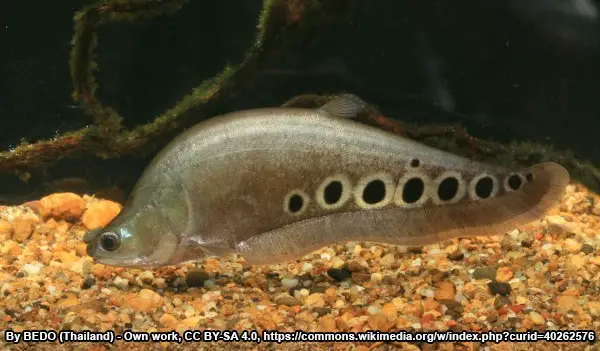
The black ghost knife fish is a commonly available species in the hobby. Black ghost knives grow as large as 20 inches (50cm). Clown knife fish, though, grow even bigger—40 inches (1 meter). Both species are strict predators in nature. They eat both fish and invertebrates. As long as your oscar is too big for a knife fish to eat, then they can be tank mates.
Can I Keep An Oscar And Giant Gourami Together?
Cichlids and gourami have a few things in common. For example, both can be aggressive fish. Also, each gourami, like each cichlid, has its own unique personality. So, as you can imagine, keeping an oscar with a giant gourami will present a similar challenge to keeping an oscar with another large cichlid, i.e. the personalities of the fish in question.
Because, if your gourami and your oscar can get along, then they’ll make reasonable tank mates for each other. Both fish are well-domesticated and as such are accustomed to a range of water parameters. While the giant gourami can reach 28 inches (71cm), yours will most likely top out at 18 inches (45cm). So, it’ll be a bit larger than your oscar, but not too much.
Conclusion
In conclusion, there are a lot of fish you can keep with an oscar. But, no fish is a perfect match. Because no two oscars are the same. Some are very aggressive, some are very passive. And everything in between. Also, the size of your aquarium—and its decorations—can impact how well your fish get along.
Some people will tell you keeping an oscar with X fish is against the rules, but then you’ll find stories online of other fishkeepers breaking that rule without any issues. Would I keep an oscar with neon tetras? No, but keeping an open mind is important. If it works, it works.
So, if you want to try keeping frontosa with your oscar… well, it’s against convention. But people have done it!



